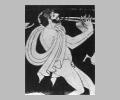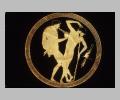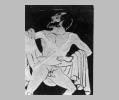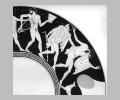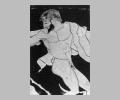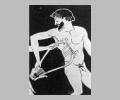| Collection: | Museum of Fine Arts, Boston |
| Summary: | Interior and exterior: revelers |
| Ware: | Attic Red Figure |
| Painter: | Attributed to Onesimos |
| Context: | From near Viterbo |
| Date: | ca. 500 BC - ca. 480 BC |
| Dimensions: | H. 0.117 m., D. 0.365 m. |
| Primary Citation: | |
| Shape: | Kylix |
| Beazley Number: | 203223 |
| Period: | Late Archaic |
Date Description:
Probably an early work of Onesimos.
Decoration Description:
Interior and exterior, revelers.
Interior in tondo: two men. One moves lightly forward, playing an aulos; the other tries to dance, but has to support himself with his staff. The flute-player wears a cloak on his shoulders, and has a short mustache, a short beard rendered by relief lines, and whiskers in brown. The other man is naked except for his shoes. A flute-case of leopard skin and a mouthpiece-box hang in the field. On the left, inscription:
Sides A and B: revelers at komos. A procession of eleven men runs around the whole cup. All are bearded men, one of whom is bald. On A, two couples and a single man. The group is led by a light-haired man, who turns back towards his companions. He wears a cloak on his shoulders, and carries a large skyphos and a stick. Behind him is a man playing an aulos, also wearing a cloak over his shoulders. Behind the flute-player is a dog wearing a collar. Behind the dog, a fairly sober man holding a stick and a large kylix, with his cloak over his left arm, looks back at his drunken companion, who has dropped his cloak and stick, and is supporting himself on his friend. Behind this pair, a bald man holding a large phiale-like bowl and a stick, with his mouth open. Under the handle, another dog. Side B: three couples. The first man staggers along with his arms extended, looking down, his cloak on his left arm. His companion, holding a stick in his left arm and extending his right, looks back at their followers. The middle group consists of another sober and drunken pair. A naked man holding a skyphos in his left hand, turns back and takes a lyre from his drunken companion, who is about to drop the instrument. The drunken man wears a cloak and carries a stick. Behind, a man with cloak and stick rushes forwards as he turns back to his naked companion. Under the handle is a pointed wine-amphora on its side. Most men wear wreaths, two of them simple fillets. Wreaths, fillets, plectrum, plectrum-cord, dog collars and inscriptions in red. Inscriptions: on A and B,
Inscriptions:
Int:
Essay:
Collection History:
Allegedly found by Pietro Saveri three miles from Viterbo. Bought by Rev. and Mrs. Hamilton Gray. In the Museum of Bethnal Green, London until 1887, when it was bought by Adolphe van Branteghem. Bought by Edward Warren for the Museum of Fine Arts in 1892.
Sources Used:
